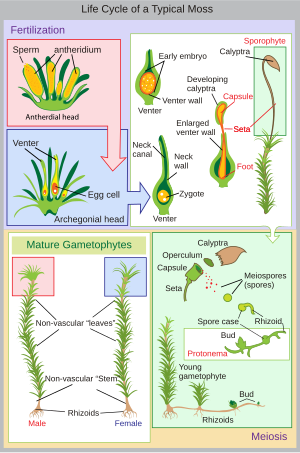AY Honors/Lichens, Liverworts & Mosses/Answer Key
1. Know the life cycle of a moss, lichen, or liverwort.
Life cycle of moss
Most kinds of plants have a double portion of chromosomes in their cells (diploid, i.e. each chromosome exists with a partner that contains the same genetic information) whilst mosses have only a single set of chromosomes (haploid, i.e. each chromosome exists in a unique copy within the cell). There are periods in the moss lifecycle when they do have a full, paired set of chromosomes but this is only during the sporophyte stage.
The life of a moss starts from a haploid spore, which germinates to produce a protonema, which is either a mass of filaments or thalloid (flat and thallus-like). This is a transitory stage in the life of a moss. From the protonema grows the gametophore ("gamete-bearer") that is differentiated into stems and leaves ('microphylls'). From the tips of stems or branches develop the sex organs of the mosses. The female organs are known as archegonia (sing. archegonium) and are protected by a group of modified leaves known as the perichaetum (plural, perichaeta). The archegonia have necks called venters which the male sperm swim down. The male organs are known as antheridia (singular antheridium) and are enclosed by modified leaves called the perigonium (plural, perigonia).
Mosses can be either dioicous or monoicous. In dioicous mosses, both male and female sex organs are borne on different gametophyte plants. In monoicous mosses, they are borne on the same plant. In the presence of water, sperm from the antheridia swim to the archegonia and fertilization occurs, leading to the production of a diploid sporophyte. The sperm of mosses have two flagella that aid in propulsion. Without water, fertilization cannot occur. After fertilization, the immature sporophyte pushes its way out of the archegonial venter. It takes about a quarter to half a year for the sporophyte to mature. The sporophyte body comprises a long stalk, called a seta, and a capsule capped by a cap called the operculum. The capsule and operculum are in turn sheathed by a haploid calyptra which is the remains of the archegonial venter. The calyptra usually falls off when the capsule is mature. Within the capsule, spore-producing cells undergo meiosis to form haploid spores, upon which the cycle can start again. The mouth of the capsule is usually ringed by a set of teeth called peristome. This may be absent in some mosses.
In some mosses, green vegetative structures called gemmae are produced on leaves or branches, which can break off and form new plants without the need to go through the cycle of fertilization. This is a means of asexual reproduction.
Life cycle of lichen
Life cycle of liverwort
2. What are lichens?
Lichens are symbiotic associations of a fungus with a photosynthetic partner (called a photobiont) that can produce food for the lichen from sunlight. The photobiont is usually either green alga or cyanobacterium.
3. Name at least two ways lichens have been of value to man.
4. How are liverworts different than all other green plants? Name one used in aquariums. What is its function?
5. Describe at least three significant ways moss has played in the economy of man.
6. Make a moss garden (small terrarium) or "eternal garden" using at least three different kinds of mosses and lichens.
7. Find and identify five lichens, one liverwort, and six mosses.
8. Observe the spore caps of several different kinds of moss under a magnifier to see the differences in "hair caps" and "teeth" that separate many species.
References
Wikipedia articles:

